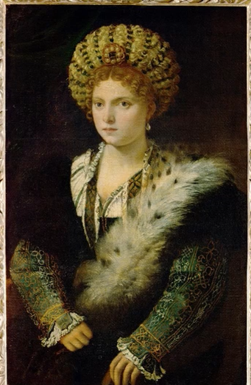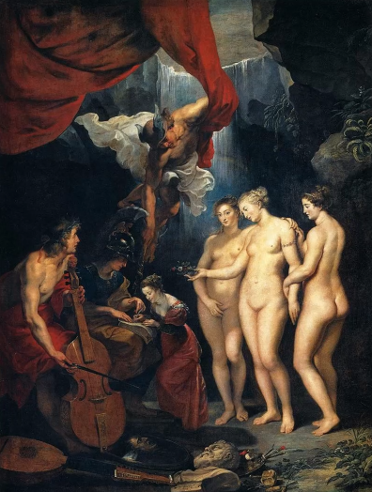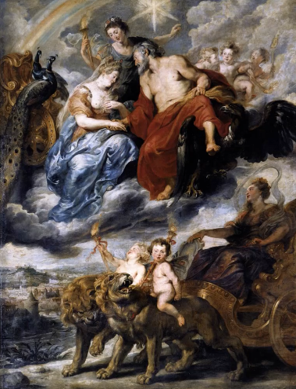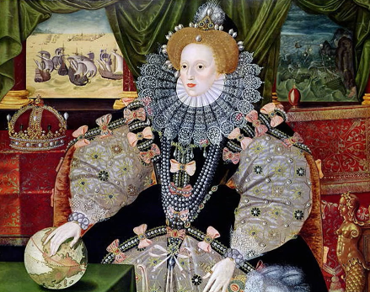Lecture 5: Women as Patrons of the Visual Arts in Early Modern Europe
1/7
There's no tags or description
Looks like no tags are added yet.
Name | Mastery | Learn | Test | Matching | Spaced |
|---|
No study sessions yet.
8 Terms
Background
Time period
Assumptions about Art (1)
Why study women patrons?
Time period
‘Early modern’ here refers to the Renaissance/Baroque
Assumptions about Art
Art is always used to express the artist’s personal concerns/thoughts
Vs. reality: for a long time, the patron was the initiator of artistic projects
Determined a work’s final appearance (e.g. its artist, material, composition, mode of display)
Why study women patrons?
Linda Nochlin: Women, whether artists or patrons, were outsiders/exceptions to the rule of the early modern period
Comparing female patrons to their male contemporaries gives us new insights on the insiders (men)
In fact, there was a notable no. of woman patrons in the early modern ages
A woman’s elite status & wealth (NOT her gender) was the most important factor determining if she could engage in patronage ⭐
Woman Patronage
Largest demographic
Struggles
Unique characteristics
Largest demographic
Nuns & widows
Only these women had the financial, legal, social independence to commission a work for herself
A girl/married lady would’ve been legally controlled by her father/husband
Struggles
External forces
E.g. widows (esp. younger ones): their families + in laws often tried to influence their art patronage
E.g. nuns: were often still under the legal & financial control of a male branch of the monastic order
Unique characteristics
Gender impacts the iconography favoured by the patron
E.g. alignment w/ female ideals of beauty & behaviour
Gender impacts the patron’s approach to patronage
E.g. women patrons exerting more control over the creation of artworks due to social expectations placed on women
Women had to ensure the final work would NOT reflect poorly on her = scandal & embarrassment

Isabella d’Este (age 60) (1534), Titian
Provenance
D’Este:
Marchioness of Mantua (a small but influential town in Italy)
Wife, NOT a widow
Married into the ruling family
Active patron
Always tried to buy the best antiquity she could afford, and hire the most famous artists of her time to work for her
Similar to male contemporaries
Described as ‘meddling & overcontrolling’ by artists she hired
Her letters evidence her efforts to ensure the artists stuck closely to her desired imagery
E.g. very detailed instructions about how each figure in a painting should look/be doing
Due to early modern social expectations about patronage & women: women had to ensure the final work would NOT reflect poorly on her = scandal & embarrassment
Description
Instead of brazenly looking the viewer in the eye, she looks slightly towards our left
Smooth, white skin
Elaborate, yet decorously-covered hairdo
Expensively elegant clothing (no metal, feathers)
Interpretation
Strategic manipulation of d’Este’s physical appearance to make her appear more youthful/beautiful
Aligns w/ typically female ideals of beauty & behaviour
A virtuous, married woman
Chaste & decorous
Youthful
Elegant
Vs. Francesco Maria I della Rovere, Duke of Urbino (ca. 1536-38), Titian
In armour, holding a phallic baton
Wrinkles & stoic facial expression; receding hairline; baggy eyes
Strategic manipulation of male physical appearance to make him appear more wise/powerful
Emphasis on age, wisdom & experience

The Education of Marie de’ Medici (1622-25), Peter Paul Rubens
Historical context
Marie de’ Medici
Part of the famous Medici family in Florence
Married the King of France, Henri IV in 1600
He had become King only by agreeing to convert to Catholicism & annulling his marriage to his 1st Protestant wife
Became Queen regent when Henri IV was murdered shortly after she was crowned Queen (son was too young to rule on his own)
Concerns as a patron:
Asserting her status as the King’s legitimate & Catholic wife
Asserting her status as the mother of the King’s legitimate & Catholic children
Description
3 nude graces
As an attribute to the Queen
Attest to her femininity
Centre: young Marie de’ Medici
Shown turning away from the 3 graces
To devote her attention to the teachings of Minerva (the Goddess of Wisdom)
Left foreground: Male God Orpheus
Gazes directly at the seductive nude graces rather than the future Queen of France
Interpretation
Orpheus assumes the role of the applied male viewer
Tensions between Rubens’s pictorial language & the main female subject
Iconography normally deployed for elite male patrons
Inability to control contemporary viewers’ actual responses
= easily misinterpreted in negative terms
Demonstrating (presumably inadvertently) how distracting Rubens’s use of bare female bodies as allegorical figures can be for contemporary male viewers
Since the palace’s most important visitors would’ve been male courtiers/the King himself

The Meeting of Maria de’ Medici & Henri IV in Lyons (1622-25), Peter Paul Rubens
Historical context
Marie de’ Medici
Part of the famous Medici family in Florence
Married the King of France, Henri IV in 1600
He had become King only by agreeing to convert to Catholicism & annulling his marriage to his 1st Protestant wife
Became Queen regent when Henri IV was murdered shortly after she was crowned Queen (son was too young to rule on his own)
Concerns as a patron:
Asserting her status as the King’s legitimate & Catholic wife
Asserting her status as the mother of the King’s legitimate & Catholic children
Description
Depicts, in highly allegorical terms, Marie’s 1st meeting w/ her husband Henri IV
Marie looks humbly downwards
Presents her bare breast to her husband
Recalls Rubens’s paintings of the Madonna and Child (the Madonna’s breast similarly bare)
Marie’s holy namesake
Interpretation
Maria’s bare breast intended to be understood as proof of her virtuous motherhood & status as an ideal bride
BUT the bare breast could also have negative associations in this period
Signifying the dangers of female seduction
E.g. Samson and Delilah (17th century), Peter Paul Rubens
Evil women using their bare breast to seduce unwary men (e.g. the hero Samson)
His hair, a symbol of his virile masculinity, is being cut off

The Armada Portrait (ca. 1588), George Gower
Historical context
NEITHER a wife NOR a widow
Single woman who was rich & powerful in her own right
Concerns as a patron:
Initially concerned w/ asserting herself as the rightful, Protestant heir of her father, Henry VIII
Made clear references to her father
Later concerned w/ asserting herself as a chaste, virgin & ever-youthful queen
She was in her late 40s and knew she would probably never marry and produce an heir to her throne
Tried to reassure her increasingly worried subjects visually that they shouldn’t worry about who would succeed her
Actively tried to control how she was portrayed
E.g. approved a limited no. of models that could be used to produce numerous approved replicas paid for by her courtiers
Provenance
Highlights her role in the English victory over the Spanish armada in 1588
Made when the Queen was >40 years old
Unmarried w/ no children
Her courtiers were encouraged to commission (approved) representations of her at their own expense
She approved a limited no. of models that could be used to produce numerous approved replicas paid for by her portraits
Description & Analysis
Spanish armada on the left, passing the Queen to meet their eventual downfall on the right (as the viewer’s eyes move from left to right)
E.g. ships sinking in storms
The Queen as a divine figure in this event
The Queen as chaste, ever-virgin and always-youthful
Symbols of chastity
E.g. draped in pearls, pink bow firmly tied over her genital area
Old-fashioned style of painting
E.g.
Blank, expressionless face
Depiction without any convincing sense of 3D space
Recalls earlier portraits of her father, Henry VIII by Hans Holbein the younger
Same anti-naturalistic & archaised style
Flat, almost cutout
Interpretation
Reminds viewers of the Queen’s quasi-saintly virtue & eternal chastity
Geraldine A. Johnson and Sara F. Matthews Grieco, (eds.). Picturing Women in Renaissance and Baroque Italy (1997), Introduction
Overall failure to completely integrate the lives & works of woman artists into the disciplinary fabric of art history
Should go BEYOND merely inserting women into the canon of (male) artistic ‘genius’
Linda Nochlin’s challenge to critique/even dismantle the discipline is still relevant
BUT many believe it has ben taken up too sporadically & usually w/ limited success
Although questions central to the practice of art history should NOT be disregarded (e.g. attribution, dating, iconography)
By engaging works of art from the POV of women as pictured & picturing, one gains a much more complex understanding of both images & the culture in which they were produced
The ways in which the real & ideal lives of women are reflected in & shaped by works of art
The gendered specificity of women’s activities as as creators, consumers, & subjects of visual culture
Possible connections to other case studies
Sarah Beetham, ‘From Spray Cans to Minivans’
Women in the South had a unique ability to memorialize the Confederate cause
In a tense postwar environment (American Civil War)
Women could couch their interest in giving soldiers proper burials and decorating their graves in the language of the domestic sphere
Grief & mourning as the prerogative of women
BUT Caroline E. Janney discovered that many of the women who participated most visibly in postwar commemorations were from elite families that did NOT have a close relative who had served in the Confederate army
= suggests that mourning was not always a primary motivation
Memorializing the Confederate soldier was an opportunity for women to engage in a political act without arousing suspicion/accusations of treason, which would’ve followed their male counterparts